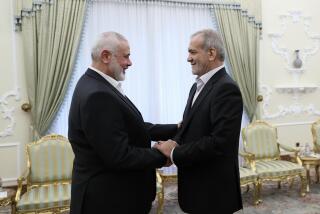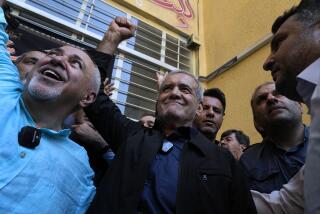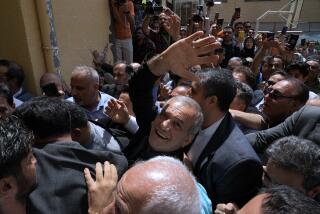From the archives: Death of The Ayatollah
CAIRO -- As millions of Iranians spilled into the streets of Tehran to mourn the death of the Ayatollah Ruhollah Khomeini, Iran’s religious hierarchy moved swiftly Sunday to avert what is still expected to be a bitter power struggle by naming President Ali Khamenei as the country’s new spiritual leader.
In an indication that things were far from settled, however, Khamenei suggested in remarks to Tehran television that his appointment might only be temporary and would depend upon the outcome of consultations on drafting a series of political and constitutional reforms
to ease Iran’s transition to the post-Khomeini era.
“We hope temporarily to fill the leadership while the terms of the new constitution are under review,” Khamenei was quoted as saying. “We must fill the vacuum, but whether this will be temporary or permanent will, God willing, be decided by (subsequent) meetings.”
Khamenei’s appointment, by the 83-member Assembly of Experts formed while Khomeini was still alive to settle the succession issue, came as a surprise to many Iran experts, who noted that the 49-year-old president’s religious ranking is not high enough to qualify him to succeed the Iranian patriarch, who died late Saturday in a Tehran hospital at the age of 86.
However, in the context of the power struggle already well under way in Iran, it was also seen by many experts as a significant boost for the political fortunes of Iranian Parliament Speaker Hashemi Rafsanjani, who is widely viewed as the man most likely to inherit Khomeini’s political, if not spiritual, authority.
“Khamenei has been Rafsanjani’s ally in the power struggle with Ahmed Khomeini,” the late ayatollah’s politically ambitious son, according to Fahmy Hueidy, a leading Egyptian expert on Iran. “Khamenei’s appointment as successor, even if only in a caretaker capacity, means that Rafsanjani will be able to work through him, at least until the next elections,” Hueidy added.
Reforms Debated
Iran is to hold new presidential elections in August, when Khamenei’s term expires, and Rafsanjani, 54, is so far the only declared candidate. Among the reforms being debated by the ruling clergy is one that would strengthen the office of the presidency by abolishing the premiership and appointing a collective religious leadership to exercise Khomeini’s spiritual authority.
Tehran Radio said Khamenei was elected by a two-thirds majority vote of the Assembly of Experts convened hours after Khomeini’s death from heart failure, which followed surgery 12 days ago for a bleeding intestine. It did not say if any other candidate sought to oppose Khamenei’s selection at the meeting, which reportedly lasted more than five hours.
Khomeini, Iran’s spiritual leader and the guiding force behind its decade-long “Islamic Revolution,” left no recognized successor, and most analysts said they thought that the current “Tehran troika”--Rafsanjani, Ahmed Khomeini and Khamenei--would exercise collective but competing rule during what is expected to be a highly unstable transitional period.
Iranian opposition groups in Europe and the Middle East predicted that Khomeini’s death would plunge the nation of 50 million into instant political turmoil, with its faction-ridden theocratic regime unable to survive for long without the anchor of the ayatollah’s undisputed authority. A senior Egyptian military official, who monitors Iran closely, said the specter of political violence and a tilt toward even further radicalism was “a strong possibility” of grave concern to the Arab states facing Iran across the Persian Gulf.
Long Transition
Other Iran experts, however, forecast a long and difficult, but not necessarily violent, transition to a post-Khomeini era that could eventually be characterized by a more stable and perhaps less revolutionary-minded regime.
“Much of what the West sees as a power struggle may, in the Iranian context, just be politics. What we will probably see is a prolonged debate which could turn violent but probably will not do so,” one gulf-based Western diplomat said.
Iran proclaimed 40 days of mourning and indicated that Khomeini’s funeral would be held today. An emotion-choked announcer on Tehran Radio appealed to Iranians to restrain their public displays of grief until then, but hundreds of thousands of black-clad mourners ignored the appeals and converged on Khomeini’s small, Spartan house in northern Tehran in a massive outpouring of emotion, reports from the Iranian capital said.
Tehran Radio said that a number of people were injured in the surging, shoving, wailing stampede through the streets, and Iranian television coverage showed several bloodied bodies being carried from the crowd for emergency treatment at a nearby mosque.
Women veiled from head to toe in black chadors wept and beat their chests, wailing over and over: “We have been orphaned. Our father is dead.” Bearded men, also weeping hysterically, flailed at their chests and pummeled their own heads with clenched fists in a traditional Shiite Muslim display of grief, oblivious to the appeals, broadcast over loudspeakers, for them to disperse.
Outpouring of Emotion
The scene recalled the massive outpouring of emotion that greeted Khomeini upon his return from exile in 1979 to overthrow the shah and launch a revolution whose reverberations would extend far beyond Iran itself: to the Persian Gulf, gripped by eight years of war between Iran and Iraq; to Lebanon, where Americans and other Western hostages are still being held by pro-Iranian groups; and to the West, where the recent furor over Khomeini’s calls for the death of British author Salman Rushdie have brought an abrupt halt to what had been Iran’s cautious rapprochement with the outside world.
To most Americans, Khomeini’s gaunt, bearded, vaguely demonic face will best be remembered in connection with the seizure of the U.S. Embassy in Tehran on Nov. 4, 1979, and the subsequent hostage crisis that would preoccupy and ultimately paralyze the Administration of President Jimmy Carter for the next 444 days.
But the seizure, with Khomeini’s open encouragement, of the 52 American hostages was only the first of several crises that many analysts believe were skillfully manipulated, if not manufactured, by the ayatollah to keep the embers of the Iranian revolution glowing. “Each time the fires of the revolution appeared to be running out of fuel, Khomeini stoked them with crises,” one Western expert said. “The U.S. hostage crisis, the war with Iraq and more recently the Rushdie affair can, I think, fairly be seen in that light.”
The Rushdie affair, widely seen by most experts as an attempt by the ailing Khomeini to put Iran back on the right revolutionary track before his death, set the stage for the current power struggle in Tehran by reimposing the isolation that Rafsanjani, the West’s favorite “moderate” mullah in Iran, had been seeking to reverse by cautiously improving ties with Europe in the wake of the Iran- Iraq War.
Major Contender
In the shifts of political fortunes that ensued, Rafsanjani was forced on the defensive, Ahmed Khomeini emerged as a major contender for his father’s authority and the Ayatollah Hussein Ali Montazeri, who until then had been Khomeini’s designated successor, was forced to resign, thus throwing the question of succession into sharp dispute on what would turn out to be the eve of the ayatollah’s death.
Ahmed Khomeini, announcing his father’s death to the nation early Sunday, pledged there would be no change in either Iran’s domestic or foreign policies.
“Vampires which cannot bear to see the sun waited for the setting of the imam’s sun in the dark world of their thoughts, but now they will see the harbinger of their final death in the formidable presence of the people,” Khomeini said. “ . . . The path and thought of the imam will continue in the Islamic Republic of Iran . . . the center of Islamic truth and the impenetrable base of struggle against infidelity, hypocrisy and the American brand of Islam.”
More to Read
Sign up for Essential California
The most important California stories and recommendations in your inbox every morning.
You may occasionally receive promotional content from the Los Angeles Times.










